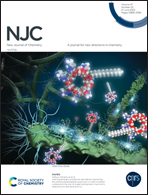Heterojunctions of N-deficient g-C3N4/1T@2H-MoS2 with interfacial C–S–Mo coordination for enhanced photocatalytic activity
Abstract
Constructing a heterojunction photocatalyst composed of two important two-dimensional (2D) materials, i.e., g-C3N4 and MoS2, to make full use of the unique advantages of each component has very important theoretical and demonstrative significance. Although it is possible to achieve enhanced visible light absorption and increased active sites in such a system, the practical difficulties stem from the loose interfacial coupling between the two and the formed type I heterostructure by specific energy level positions, which are both unfavorable for suppressing the recombination of photogenerated carriers. By creating N vacancies on g-C3N4 flakes and then inducing S atoms to enter the nitrogen vacancies to form Mo–S–C bonds, we prepared a tightly coupled heterojunction with strong electronic interfacial interaction. Not only that, MoS2 loaded onto g-C3N4 nanosheets exhibited a mixed-phase structure, in which the semiconducting (2H-MoS2) and metallic (1T-MoS2) phases act as good photosensitizers and electron acceptors, respectively. Due to the close contact and the synergistic effect of the MoS2 mixed phase, the currently designed unique heterostructure photocatalyst has greatly improved catalytic performance under visible light, which may provide new ideas for the hierarchical structure design of photocatalysts.



 Please wait while we load your content...
Please wait while we load your content...